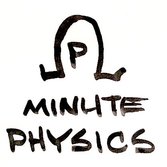 If you’re reading this blog, there is a reasonably good chance that you’ve heard of the YouTube channel MinutePhysics and its sister-channel MinuteEarth. I haven’t done an exhaustive survey, but I have certainly heard from many educators that they enjoy these videos consisting of short, time-lapsed drawings. With well over three million subscribers, these videos have no-doubt made their way into many classrooms. Last May, I attended ComSciCon and MinutePhysics founder Henry Reich was on a panel. Among the audience of science communicators, (admittedly a pretty niche crowd), MinutePhysics and MinuteEarth were definitely well known and well received.
If you’re reading this blog, there is a reasonably good chance that you’ve heard of the YouTube channel MinutePhysics and its sister-channel MinuteEarth. I haven’t done an exhaustive survey, but I have certainly heard from many educators that they enjoy these videos consisting of short, time-lapsed drawings. With well over three million subscribers, these videos have no-doubt made their way into many classrooms. Last May, I attended ComSciCon and MinutePhysics founder Henry Reich was on a panel. Among the audience of science communicators, (admittedly a pretty niche crowd), MinutePhysics and MinuteEarth were definitely well known and well received.
So I was a bit surprised when Bertha Vazquez (she of TIES) wrote to me asking if I’d seen MinutePhysics’s video on evolution. In her eyes, it was very problematic and she wanted my take. So I looked and… yikes.
It starts with this line:
Most of us hear the word “evolution” and think of the process by which species change and adapt and maybe turn into other species or go extinct—but that’s specifically the evolution of life forms by means of natural selection.
There is a minor and a more major issue here. The minor one is that saying species “maybe turn into other species” makes it seem kind of like a magic trick—“Presto chango! You’re now a chicken, Mr. Velociraptor!” Now it is true that linear evolution (anagenesis if you are hankering for a new word to throw around) has been proposed in some cases, but I think it’s fair to say that even then, it’s less “poof!” and more “keep your eyes on the population for a few thousand years.” Why not just say, “and sometimes form new species,” Mr. Narrator? That’d be better.
As for the larger of my quibbles from this section—you know what I’m going to say, right? Not all evolution occurs by natural selection. To think it does lends itself to a hyper-adaptive view of life and all of a sudden, birds evolved wings so that they could fly and belly buttons evolved so that they could collect lint. What the narrator should have said is: “…but that’s specifically the biological evolution of life forms.”
He (the narrator) would then do well to amend his next line, too, that “Evolution in general means ‘”change or development.’” True—all development is change, but not all change is development. This phrasing makes them seem interchangeable, when in fact, confusing development with biological evolution is part of the misconception that individuals evolve. So, better not to bring up development at all in a piece about what evolution means unless you plan to explicitly call attention to the differences between the two.
Now, I almost like what Mr. Narrator says a bit later: “There absolutely was [at the time Darwin published Origin] and is no denying that life on Earth changes—and change over time is what “evolution” means. What Darwin proposed with his theory of natural selection was an explanation for how this change (which is stupidly well supported by evidence) could have occurred naturally.”
Not bad. An explanation, not the explanation. And you all know I love humorous hyperbole, so bonus points for the phrase “stupidly well supported”. But I do have a small quibble. If the point of this video is to explain the differences among different uses of the term “evolution", it would be good to be specific with your different meanings. Thus, “change over time is what ‘evolution’ means” would be much better stated as “genetic change over generations is what biological evolution means.”
But where this video really jumps into serious Say What?! territory is in the next section:
You can think of it like the Challenger disaster of 1986: All of the evidence showed that the collection of molecules named “Challenger” had tragically evolved from a space shuttle and its rocket booster into a cloud of gas and debris shortly after launch. The question for scientists at the time was to understand and explain how the explosion had happened so they could prevent it in the future. Ultimately, it was the Theory of Frozen O-rings in the Rocket Boosters, popularized by Richard Feynman, that provided a satisfactory explanation for the cause of the disaster. Now, you’re welcome to disagree with Feynman’s explanation for the explosion, or Darwin’s explanation for how life on earth changes, but they’re pretty darn good explanations for these incredibly well documented examples of change in the universe.
So. Much. Bad. First, and most fundamentally, wasn’t the point supposed to be to explain the differences among uses of "evolution"? Why all of a sudden is the explosion of the Challenger being likened to evolution by natural selection? Yes, both were changes…but that’s about where the similarities stop. And this comparison is particularly terrible because it suggests that there is one lynchpin piece of evidence,  like the Challenger’s O-ring, that will prove biological evolution. Two major issues arise from this suggestion: 1) Deniers will want us to show them the O-ring and 2) we don’t have an O-ring. We have a zillion data points and empirical observations, which is of course, way better than one discrete thing, but a lot less harder to “sell” to someone demanding a magic bullet of proof.
like the Challenger’s O-ring, that will prove biological evolution. Two major issues arise from this suggestion: 1) Deniers will want us to show them the O-ring and 2) we don’t have an O-ring. We have a zillion data points and empirical observations, which is of course, way better than one discrete thing, but a lot less harder to “sell” to someone demanding a magic bullet of proof.
Even the phrase “Theory of Frozen O-Rings” is highly problemmatic because a single cause-and-effect chain does not rise to the level of a scientific theory. We don’t go around talking about the “Theory of the Empty Gas Tank” to explain what happens when we run out of gas, or the “Theory of the Blocked Drain” when we try to put too many potato peelings down the disposal on Thanksgiving Day, do we? No. And this—joke? Is it meant to be a joke?—of using the phrase “The Theory of Frozen O-Rings” makes light of the very high bar that scientific theories have to clear to merit that name. This is especially frustrating given the huge issue we have with conflating the meaning of “theory” when it comes to science vs. its colloquial “Here’s a crazy idea!” meaning.
Finally, Mr. Narrator ends with this:
In the end, the universe will go on evolving regardless of whether you and I believe in it or understand it, and perhaps the best thing to do is to remember that it’s ok for our beliefs and opinions and understandings to evolve too. That’s part of life, and it’s the way of science.
Seriously? Yes, beliefs, opinions, and understandings change—but holy moly that is not the way of science. Beliefs and opinions have no standing in science, and understandings don’t just change willy nilly, they change based on evidence, and it’s more than “okay” that they change based on evidence—it’s imperative.
To my dismay, Bertha wrote to the MinutePhysics founder making most of these points, but never got a reply. Too bad—because how real science works is how we change our understandings based on new information. If Henry Reich wants to model being a scientist for his audience, he should revise his video.
If you agree, let him know:
<Twitter> @minutephysics
https://www.facebook.com/MinutePhysics
Are you a teacher and want to tell us about an amazing free resource? Do you have an idea for a Misconception Monday or other type of post? Have a fossil to share? See some good or bad examples of science communication lately? Drop me an email or shoot me a tweet @keeps3.

